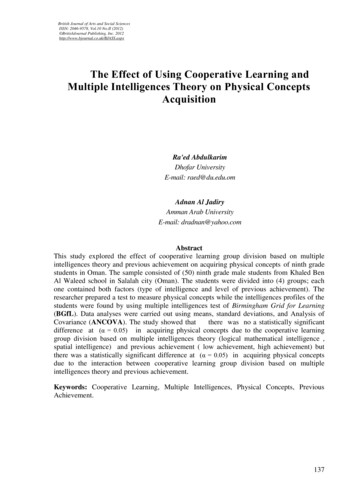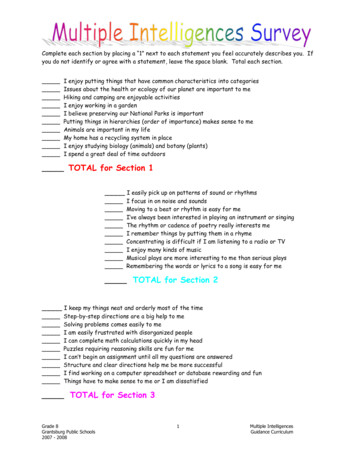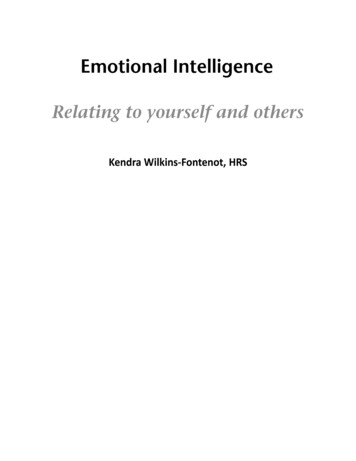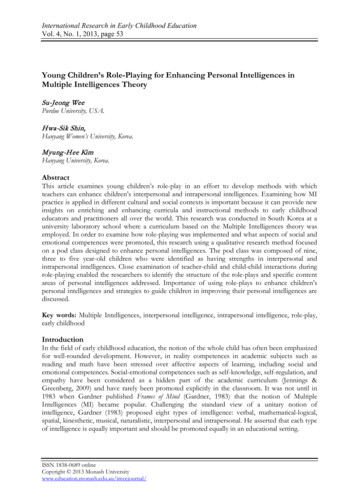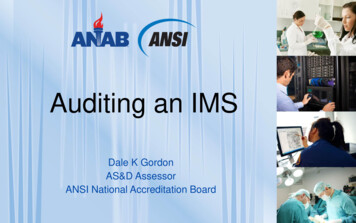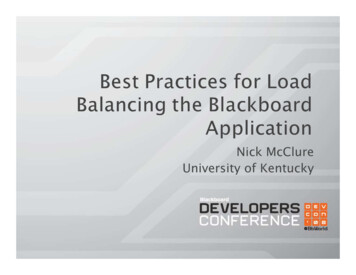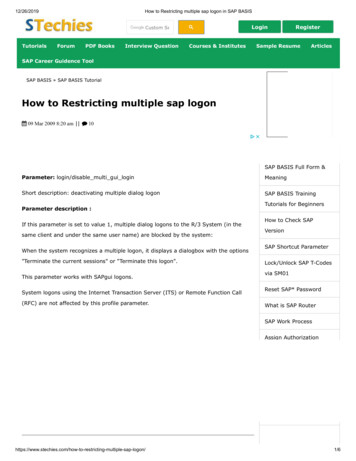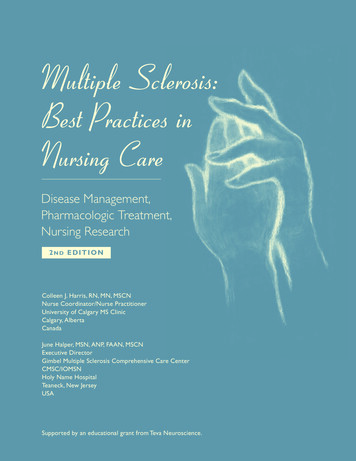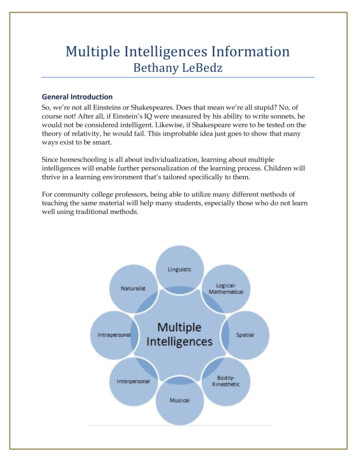
Transcription
Multiple Intelligences InformationBethany LeBedzGeneral IntroductionSo, we’re not all Einsteins or Shakespeares. Does that mean we’re all stupid? No, ofcourse not! After all, if Einstein’s IQ were measured by his ability to write sonnets, hewould not be considered intelligent. Likewise, if Shakespeare were to be tested on thetheory of relativity, he would fail. This improbable idea just goes to show that manyways exist to be smart.Since homeschooling is all about individualization, learning about multipleintelligences will enable further personalization of the learning process. Children willthrive in a learning environment that’s tailored specifically to them.For community college professors, being able to utilize many different methods ofteaching the same material will help many students, especially those who do not learnwell using traditional methods.
LeBedz/Multiple IntelligencesFrequently Asked QuestionsWhat are multiple intelligences (MI)?A: “Human beings possess a range of capacities and potentials—multipleintelligences—that, both individually and in consort, can be put to many productiveuses,” (Gardner, 1999, pg. 4).Why should we think about MI?A: Students learn more difficult (for them) academic subjects better when teachers usetheir primary intelligences to present new information.Who should use MI strategies?A: The short answer is everyone! Teachers of all ages and parents should be especiallyin tune with the intelligences of those whom they teach and/or influence.When should we start/stop employing MI theories?A: We should start employing specific MI theories as soon as our children showpreferences toward certain intelligences. New approaches can be added to our teachingrepertoire as we notice new aptitudes. As long as we are teaching, we shouldn’t stopusing MI theories.Where can we employ MI strategies?A: We can employ MI strategies at home during homeschooling (or during the earlyyears and homework time for nonhomeschoolers). We can utilize them in everyclassroom, including college classrooms.How can we utilize MI for academic success?A: Everyone has some measure of all of the eight intelligences. People are morestrongly inclined to one or two than to the rest. All of the intelligences can be cultivatedby everyone.www.bethanylebedz.com2
LeBedz/Multiple IntelligencesLinguistic IntelligenceGeneral CharacteristicsA person with a high degree of linguistic intelligence displays “asensitivity to the meaning of words . . . a sensitivity to the order amongwords . . . a sensitivity to the sounds, rhythms, inflections, and meters ofwords . . . and a sensitivity to the different functions of language,”(Gardner 1993, pg. 77).Curricula Planning Lectures Discussions Storytelling JournalingTools BooksComputersStamp setsBooks on tape/CD/mp3Teaching StrategiesObjective: Incorporate spoken and/orwritten words Read it Write it Talk about it Listen to it (words)Assessments Oral or written report Oral or writteninterpretation/commentary Explain a concept verbally or in writingwww.bethanylebedz.com3
LeBedz/Multiple IntelligencesLogical-Mathematical IntelligenceGeneral CharacteristicsThe logical-mathematical intelligence has at its roots “aconfrontation with the world of objects,” (Gardner 1993, pg.129). People displaying a high level of logical-mathematicalintelligence can usually calculate arithmetic problems veryquickly, even advanced problems. A high affinity for scientificendeavors also falls into this category. These individuals are attracted to order andpatterns, especially as it relates to numbers and mathematical and scientific symbols.Curricula Planning Brain teasers Problem solving Science experiments Number gamesTools CalculatorsMath manipulativesMath gamesScience equipmentTeaching StrategiesObjective: Incorporate numbers, calculations, logic,classifications, and critical thinking skills Quantify Think critically Logical framework Experiments Socratic questioningAssessments Present statistics Present sequential cause-effect chart Write down formulas Quantifywww.bethanylebedz.com4
LeBedz/Multiple IntelligencesSpatial IntelligenceGeneral Characteristics“Central to spatial intelligence are the capacities to perceive thevisual world accurately, to perform transformations andmodifications upon one’s initial perceptions, and to be able torecreate aspects of one’s visual experience, even in the absence ofrelevant physical stimuli,” (Gardner 1993, pg. 173).** All personas drawn by Meghan LeBedz. **Curricula Planning Visual presentations Art Imagination games Mind mapping Metaphors VisualizationsTools GraphsMapsVideosArt materialsOptical illusionsPicturesDigital camerasColor cuesGraphic symbolsTeaching StrategiesObjective: Incorporate visual aids, color, art, shapes, metaphors, and visualizations See Draw Visualize Color Mind mapAssessments Draw maps and diagrams Develop flow charts Draw a series of sketcheswww.bethanylebedz.com5
LeBedz/Multiple IntelligencesBodily-Kinesthetic IntelligenceGeneral CharacteristicsPeople displaying bodily-kinesthetic intelligence can “use one’s body inhighly differentiated and skilled ways, for expressive as well as goaldirected purposes,” (Gardner 1993, pg. 206). You may recognize themas the boys with ants in their pants or the girls who dance from room toroom.Curricula Planning Hands-on learning Drama Dance Sports Tactile activities Field trips CraftsTools Building toolsClaySports equipmentManipulativesGesturesTeaching StrategiesObjective: Incorporate the wholebody and hands-on experiences Build Act Touch Feel Dance MoveAssessments Create 3-D maps and dioramas Pantomime roles/characters Build structures and models Create cheers or danceswww.bethanylebedz.com6
LeBedz/Multiple IntelligencesMusical IntelligenceGeneral CharacteristicsPeople who exhibit a strong inclination to musical intelligence embodythe definite pitch, rhythm, and timbre aspects of music. They love to listento music, and they love to create (on different levels) music. They usuallyhave strong emotional reactions to certain music as well.Curricula Planning Raps Music Facts set to music Rhythms Mood music (background)Tools CD player/CDs/mp3sRhythm instrumentsMusical (melody) instrumentsMusic softwareTeaching StrategiesObjective: Incorporate music,environmental sounds, and rhythms Sing Rap Listen Play instrumentAssessments Collect music from time period being studied Create a song or rhythm for a set of facts Choose music to depict characters, characteristics, movementwww.bethanylebedz.com7
LeBedz/Multiple IntelligencesInterpersonal IntelligenceGeneral CharacteristicsThose individuals who appropriately and frequently hone in onothers’ feelings, display empathy towards others, and interact withothers are gifted with interpersonal intelligence. A tenderheartedchild may often be in tears on behalf of others.Curricula Planning Cooperative learning Peer tutoring Social gatherings Simulations Apprenticeships Academic clubsTools Board gamesParty suppliesProps for role playsInteractive softwareTeaching StrategiesObjective: Incorporate peer sharing,cooperative learning, and groupdiscussions Teach Collaborate InteractAssessments Design class simulation Discuss events, details, facts, etc. learned Demonstrate concepts using people placed in certain ways (act out)www.bethanylebedz.com8
LeBedz/Multiple IntelligencesIntrapersonal IntelligenceGeneral CharacteristicsA strong sense of self characterizes those with a high level ofintrapersonal intelligence. These people feel deeply, can identify thosefeelings, and can express those feelings.Curricula Planning Individualized teaching Independent study Self-esteem building Private place for studying Goal-setting lessonsTools Self-checking materials JournalsTeaching StrategiesObjective: Incorporate personalfeelings, memories, and choices Connect to personal life Make choices ReflectionAssessments Journal writing Relate characters and events to own life Create scrapbook with facts learnedwww.bethanylebedz.com9
LeBedz/Multiple IntelligencesNaturalist IntelligenceGeneral CharacteristicsIndividuals with naturalist intelligence are very in tune with theirsurroundings, especially their living surroundings. They’re drawn toanimals, plants, and ecology issues.Curricula Planning Nature study Ecology Take care of animals Environmental awareness Nature walksTools PlantsAnimalsGardeners’ toolsNaturalists’ toolsNature videosWeather stationTeaching StrategiesObjective: Incorporate nature, livingthings, and ecological awareness Connections to living things andnatural phenomena Emphasize awareness ofsurroundingsAssessments Examine geographical features and contributions to history Compare character development to an ecosystem development Explain phenomena using animal analogieswww.bethanylebedz.com10
LeBedz/Multiple IntelligencesResourcesArmstrong, T. (2000). Multiple intelligences in the classroom. Alexandria: Association forSupervision and Curriculum Development.Armstrong, T. (2011). Honoring diversity in human growth andlearning. http://www.thomasarmstrong.com/index.phpChau, M. Y. (2006). Connecting learning styles and multiple intelligences theories throughlearning strategies: An online tutorial for library instruction. Library and Information ScienceResearch Electronic Journal, 16(1), 1–14. http://dx.doi.org/10.1207/s15326985ep4104 6Concept to classroom workshop: Tapping into multiple intelligences. (2004). EducationalBroadcasting Corporation. index.htmlGardner, H. (1993). Frames of mind: The theory of multiple intelligences. New York: Basic Books.Gardner, H. (1993). Multiple intelligences: The theory in practice. New York: Basic Books.Gardner, H. (1999). Intelligence reframed: Multiple intelligences for the 21st century. New York:Basic Books.Gardner, H. (2006). Multiple intelligences: New horizons. New York: Basic Books. Howard Gardner.(2010). The Project Zero website of HarvardUniversity. http://pzweb.harvard.edu/PIs/HG.htmLeBedz, B. (2012). http://www.bethanylebedz.comLeBedz, M. (2012). Multiple intelligences personas.McCoog, I. (2010). “Integrated instruction: Multiple intelligences and technology.” The ClearingHouse: A Journal of Educational Strategies, Issues and Ideas, 81(1), 25–28.Routledge. doi:10.3200/TCHS.81.1.25-28Multiple intelligences for adult literacy and education. Literacy Workshttp://www.literacyworks.org/mi/home.htmlThe Birmingham Grid for Learning, Interactive Multiple Intelligencesquiz/assessment. http://www.bgfl.org/bgfl/custom/resources ftp/client ftp/ks1/ict/multiple int/index.htmWarner, M. A. (2007). Discover Gardner’s multiple intelligences classroom activities and lessonplans. om11
Multiple Intelligences Information Bethany LeBedz General Introduction So, we’re not all Einsteins or Shakespeares. Does that mean we’re all stupid? No, of course not! After all, if Einstein’s IQ were measured by his ability to write sonnets, he would not be considered intelligent. Likewise, if Shakespeare were to be tested on the theory of relativity, he would fail. This improbable idea .
